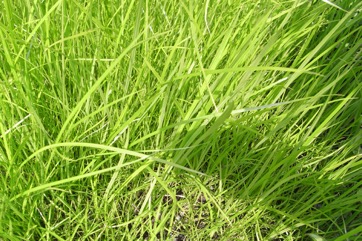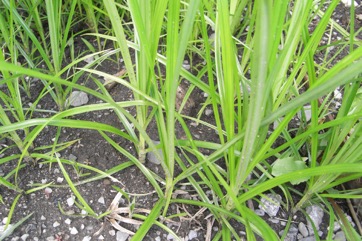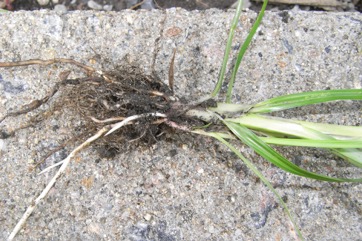Yellow Nutsedge, Tiger nut

A tropical plant. It grows throughout the tropics and warm temperate zone. It is common in seasonally dry grasslands. It does not tolerate shade. High temperatures (27-30°C) and low nitrogen favours tuber production. It grows best in sandy soils with pH 5.5-6.5. It can tolerate salty soils. Day lengths of 8-12 hours favours tuber production. Day lengths of over 16 hours favour vegetative growth. It can grow in arid places. In Yunnan.
Also known as:
Abdulaziz, Abide, Aya, Banhamo, Bibi, Ceko, Chichoda, Chimbwe-chimbwe, Chufa, Chufa salvaje, Dila, Dim, Djardole, Earth almonds, Enensa, Fio, Gaasu, Gocoso, Goon, Haya, Imumu, Inqoba, Junca, Kaothum, Karepoka, Karekika, Kaseru, Kaseruka, Keseru, Kwentii, Motha, Ndao, Ndawi, Noem phlong, Nut Sedge, Nut-grass, Ofio, Amu, Omu, Pfende, Rush nuts, Sekwa, Tiger nut, Tiririca, Umhlata, Yanaacemmora, Zulu nut
Synonyms
- Cyperus aureus Ten.[Illegitimate]
- Cyperus nervoso-striatus Turrill
- Cyperus melanorhizus Delile
- Pycreus esculentus (L.) Hayek
- and many others
Edible Portion
- Tubers, Oil, Bulb, Vegetable, Root, Coffee
Where does Yellow Nutsedge grow?
Found in: Africa, Albania, Argentina, Asia, Australia, Benin, Bolivia, Botswana, Brazil, Bulgaria, Burkina Faso, Cambodia, Cameroon, Canada, Central Africa, Chad, Chile, China, Congo, Côte d'Ivoire, Czech Republic, East Africa, Egypt, Eswatini, Ethiopia, Europe, France, Gambia, Germany, Ghana, Greece, Guatemala, Guinea, Guinée, Guinea-Bissau, Haiti, Hawaii, Hungary, India, Indochina, Indonesia, Italy, Ivory Coast, Laos, Libya, Madagascar, Malawi, Mali, Mauritania, Mediterranean, Mexico, Mozambique, Myanmar, Namibia, Netherlands, Niger, Nigeria, North Africa, North America, Northeastern India, Oman, Pakistan, Panama, Paraguay, Portugal, Sao Tome and Principe, SE Asia, Senegal, Sierra Leone, Somalia, Spain, South Africa, South America, Southern Africa, South Sudan, Spain, St Helena, Sudan, Swaziland, Taiwan, Tanzania, Togo, Turkey, Uruguay, United States, Venezuela, West Africa, West Indies, Yemen, Zambia, Zimbabwe
Notes: There are 550 Cyperus species.
Status: It is a commercially cultivated vegetable. It is an important food of several tribes in Africa. They are sold in markets in India. They are cultivated in Spain.
Growing Yellow Nutsedge, Tiger nut
Cultivation: Plants are grown from tubers. Tubers are soaked in water for 24-36 hours before being planted out. Sometimes tubers remain dormant but if they are chilled they grow better and produce more tubers. A spacing of 10-15 cm apart along rows 60 to 90 cm apart are suitable. Tubers should be placed 2.5-4 cm deep. The tubers are dug, washed and dried for 1-3 days before being sold or used.
Edible Uses: The tubers are eaten raw or baked. Sometimes they are ground into flour and boiled into a porridge. (If eaten raw they can carry contaminants that cause sickness) The oil from the tubers can be used for cooking. It is edible. The roasted tubers are used as a coffee substitute. The tubers are used as a source of potash for softening and flavouring green leafy vegetables.
Production: Yields of 800-900 kg per hectare of tubers are achieved on sandy soils. Yields of 8000-14000 kg per hectare are possible. Tiger nuts take 90-120 days to reach maturity.
Nutrition Info
per 100g edible portion| Edible Part | Energy (kcal) | Protein (g) | Iron (mg) | Vitamin A (ug) | Vitamin c (mg) | Zinc (mg) | % Water |
|---|---|---|---|---|---|---|---|
| Rhizome | 302 | 3.5 | 8 | - | - | - | 36.5 |
| Bulb - nuts | 82 | 0.9 | 4.2 | - | 21 | 0.6 | 77.4 |
Yellow Nutsedge, Tiger nut Photos



References
Abbiw, D.K., 1990, Useful Plants of Ghana. West African uses of wild and cultivated plants. Intermediate Technology Publications and the Royal Botanic Gardens, Kew. p 30
Abano, E. E. and Amoah, K. K. (2011), Effect of moisture content on the physical properties of tiger nut (Cyperus esculentus), Asian Journal of Agricultural Research 5, pp. 56–60
Adejuyitan, J. A., Otunola, E. T., Akande, E. A., Bolarinwa, I. F. and Oladokun, F. M., 2009, Some physicochemical properties of flour obtained from fermentation of tiger nut (Cyperus esculentus) sourced from a market in Ogbomoso, Nigeria, African Journal of Food Science, Vol 3(2) pp. 51-53.
Ambasta, S.P. (Ed.), 2000, The Useful Plants of India. CSIR India. p 157
Asfaw, Z., Conservation and use of traditional vegetables in Ethiopia. FAO
Asfaw, Z. and Tadesse, M., 2001, Prospects for Sustainable Use and Development of Wild Food Plants in Ethiopia. Economic Botany, Vol. 55, No. 1, pp. 47-62
Beckstrom-Sternberg, Stephen M., and James A. Duke. "The Foodplant Database." http://probe.nalusda.gov:8300/cgi-bin/browse/foodplantdb.(ACEDB version 4.0 - data version July 1994)
Belewu, M. A. and Abodunrin, O. A., 2008, Preparation of Kunnu from Unexploited Rich Food Source: Tiger Nut (Cyperus esculentus), Pakistan Journal of Nutrition 7: pp. 109–110.
Blamey, M and Grey-Wilson, C., 2005, Wild flowers of the Mediterranean. A & C Black London. p 529
Bodkin, F., 1991, Encyclopedia Botanica. Cornstalk publishing, p 316
Burkill, H. M., 1985, The useful plants of west tropical Africa, Vol. 1. Kew.
Cherikoff V. & Isaacs, J., The Bush Food Handbook. How to gather, grow, process and cook Australian Wild Foods. Ti Tree Press, Australia p 194
Cribb, A.B. & J.W., 1976, Wild Food in Australia, Fontana. p 157
Dansi, A., et al, 2012, Diversity of the Neglected and Underutilized Crop Species of Importance in Benin. The Scientific World Journal. Volume 2012, Article ID 932947, 19 pages
Devi, O.S., P. Komor & D. Das, 2010, A checklist of traditional edible bio-resources from Ima markets of Imphal Valley, Manipur, India. Journal of Threatened Taxa 2(11): 1291-1296
Dogan, Y., et al, 2004, The Use of Wild Edible Plants in Western and Central Anatolia (Turkey). Economic Botany 58(4) pp. 684-690
Duke, J.A., 1992, Handbook of Edible Weeds. CRC Press. p 82
Ekman Herbarium records Haiti
Elias, T.S. & Dykeman P.A., 1990, Edible Wild Plants. A North American Field guide. Sterling, New York p 130
Ertug, F, Yenen Bitkiler. Resimli Türkiye Florası -I- Flora of Turkey - Ethnobotany supplement
Esperanca, M. J., 1988. Surviving in the wild. A glance at the wild plants and their uses. Vol. 1. p 227
Facciola, S., 1998, Cornucopia 2: a Source Book of Edible Plants. Kampong Publications, p 90
FAO, 1988, Traditional Food Plants, FAO Food and Nutrition Paper 42. FAO Rome p 239
Flora of Pakistan. www.eFloras.org
Flowerdew, B., 2000, Complete Fruit Book. Kyle Cathie Ltd., London. p 209
Fowler, D. G., 2007, Zambian Plants: Their Vernacular Names and Uses. Kew. p 66
Fox, F. W. & Young, M. E. N., 1982, Food from the Veld. Delta Books. p 179
Gallagher, D. E., 2010, Farming beyond the escarpment: Society, Environment, and Mobility in Precolonial Southeastern Burkina Faso. PhD University of Michigan.
Gouldstone, S., 1983, Growing your own Food-bearing Plants in Australia. Macmillan p 182
Grivetti, L. E., 1980, Agricultural development: present and potential role of edible wild plants. Part 2: Sub-Saharan Africa, Report to the Department of State Agency for International Development. p 24
Grubben, G. J. H. and Denton, O. A. (eds), 2004, Plant Resources of Tropical Africa 2. Vegetables. PROTA, Wageningen, Netherlands. p 561
Hanawa, Y., 2013, Wild edible plants used by Guiziga people of far north region of Cameroon. Int. J. Med. Arom. Plants. Vol 3 (2) : 136-143
Hedrick, U.P., 1919, (Ed.), Sturtevant's edible plants of the world. p 262
Heywood, V.H., Brummitt, R.K., Culham, A., and Seberg, O., 2007, Flowering Plant Families of the World. Royal Botanical Gardens, Kew. p 364
Hibbert, M., 2002, The Aussie Plant Finder 2002, Florilegium. p 79
Hu, Shiu-ying, 2005, Food Plants of China. The Chinese University Press. p 299
Jardin, C., 1970, List of Foods Used In Africa, FAO Nutrition Information Document Series No 2.p 74
Kay, D.E., 1973, Root Crops, Digest 2, Tropical Products Institute, London, p 50
Kays, S. J., and Dias, J. C. S., 1995, Common Names of Commercially Cultivated Vegetables of the World in 15 languages. Economic Botany, Vol. 49, No. 2, pp. 115-152
Kinupp, V. F., 2007, Plantas alimenticias nao-convencionais da regiao metropolitana de Porto Alegre, RS, Brazil p 75
Kiple, K.F. & Ornelas, K.C., (eds), 2000, The Cambridge World History of Food. CUP p 1756
Lazarides, M. & Hince, B., 1993, Handbook of Economic Plants of Australia, CSIRO. p 74
Lim, T. K., 2015, Edible Medicinal and Non Medicinal Plants. Volume 9, Modified Stems, Roots, Bulbs. Springer p 32
Long, C., 2005, Swaziland's Flora - siSwati names and Uses http://www.sntc.org.sz/flora/
Lulekal, E., et al, 2011, Wild edible plants in Ethiopia: a review on their potential to combat food insecurity. Afrika Focus - Vol. 24, No 2. pp 71-121
Lyle, S., 2006, Discovering fruit and nuts. Land Links. p 173
MacKinnon, A., et al, 2009, Edible & Medicinal Plants of Canada. Lone Pine. p 373
Macmillan, H.F. (Revised Barlow, H.S., et al) 1991, Tropical Planting and Gardening. Sixth edition. Malayan Nature Society. Kuala Lumpur. p 338
Malaisse, F., 1997, Se nourrir en floret claire africaine. Approche ecologique et nutritionnelle. CTA., p 61
Malezas Comestibles del Cono Sur, INTA, 2009, Buernos Aires
Maroyi, A., 2011, The Gathering and Consumption of Wild Edible Plants in Nhema Communal Area, Midlands Province, Zimbabwe. Ecology of Food and Nutrition 50:6, 506-525
Maroyi, A., 2013, Use of weeds as traditional vegetables in Shurugwi District, Zimbabwe. Journal of Ethnobiology and Ethnomedicine 9:60
Okigbo, B.N., Vegetables in Tropical Africa, in Opena, R.T. & Kyomo, M.L., 1990, Vegetable Research and development in SADCC countries. Asian Vegetable Research and development Centre. Taiwan. p 38
Parker, M. L., 2000, Esterified Phenolics of the Cell Walls of Chufa (Cyperus esculentus L.) Tubers and Their Role in Texture. Journal of Agricultural and Food Chemistry. 48:6284-6291
Peters, C. R., O'Brien, E. M., and Drummond, R.B., 1992, Edible Wild plants of Sub-saharan Africa. Kew. p 15
Phon, P., 2000, Plants used in Cambodia. © Pauline Dy Phon, Phnom Penh, Cambodia. 191
Plants for a Future database, The Field, Penpol, Lostwithiel, Cornwall, PL22 0NG, UK. http://www.scs.leeds.ac.uk/pfaf/
Plants of Haiti Smithsonian Institute http://botany.si.edu/antilles/West Indies
Romanowski, N., 2007, Edible Water Gardens. Hyland House. p 86
Ruiters-Welcome, A. K., 2019, Food plants of southern Africa. Ph.D. thesis. Univ. of Johannesburg p 51
Royal Botanic Gardens, Kew (1999). Survey of Economic Plants for Arid and Semi-Arid Lands (SEPASAL) database. Published on the Internet; http://www.rbgkew.org.uk/ceb/sepasal/internet [Accessed 16th April 2011]
Saunders, C.F., 1948, Edible and Useful Wild Plants. Dover. New York. p 25
Segnon, A. C. & Achigan-Dako, E. G., 2014, Comparative analysis of diversity and utilization of edible plants in arid and semi-arid areas in Benin. Journal of Ethnobiology and Ethnomedicine 2014, 10:80
Shava, S., 2000, The Use of Indigenous Plants as Food by a Rural Community in the Eastern Cape: an Educational Exploration. Masters Thesis Rhodes University. p 63
Simkova, K. et al, 2014, Ethnobotanical review of wild edible plants used in the Czech Republic. Journal of Applied Botany and Food Quality 88, 49-67
Simpson, D. A. & Inglis, C. A., 2001, Cyperaceae of Economic, Ethnobotanical and Horticultural Importance: A checklist. Kew Bulletin Vol. 56, No. 2 (2001), pp. 257-360
Singh, H.B., Arora R.K.,1978, Wild edible Plants of India. Indian Council of Agricultural Research, New Delhi. p 12
Singh, V. and Singh, P., 1981, Edible Wild Plants of Eastern Rajasthan. J. Econ. Tax. Bot. Vol 2 pp 197-207
Singh, P.K., Singh, N.I., and Singh, L.J., 1988, Ethnobotanical Studies on Wild Edible Plants in the Markets of Manipur - 2. J. Econ. Tax. Bot. Vol. 12 No. 1 pp 113-119
Sp. pl. 1:45. 1753
Standley, P. & Steyermark, J., 1958, Flora of Guatemala. Fieldiana: Botany, Volume 24 part 1 p 122, 347
Swaziland's Flora Database http://www.sntc.org.sz/flora
Terra, G.J.A., 1973, Tropical Vegetables. Communication 54e Royal Tropical Institute, Amsterdam, p 43
Tredgold, M.H., 1986, Food Plants of Zimbabwe. Mambo Press. p 22
Tronickova, E. & Krejcova, Z., 1987, Ortaggi, Instituto Geografico de Agostini, Cecoslovacchia. p 60
Ubom, R. M., 2010, Ethnobotany and Diversity Conservatioon in the Niger Delta, Nigeria. International Journal of Botany. 6(3): 310-322
USDA, ARS, National Genetic Resources Program. Germplasm Resources Information Network - (GRIN). [Online Database] National Germplasm Resources Laboratory, Beltsville, Maryland. Available: www.ars-grin.gov/cgi-bin/npgs/html/econ.pl (10 April 2000)
Vanderjagt, F. J., et al, 2000, The trypsin inhibitor content of 61 wild edible plant foods of Niger. Plant Foods for Human Nutrition 55: 335–346, 2000.
van Wyk, B., 2005, Food Plants of the World. An illustrated guide. Timber press. p 171
van Wyk, Be., & Gericke, N., 2007, People's plants. A Guide to Useful Plants of Southern Africa. Briza. p 86
Vernon, R., 1983, Field Guide to Important Arable Weeds of Zambia. Dept of Agriculture, Chilanga, Zambia. p 104
Wickens, G.E., 1995, Edible Nuts. FAO Non-wood forest products. FAO, Rome. p160
Wild edible plants of Himachal Pradesh
World Checklist of Useful Plant Species 2020. Royal Botanic Gardens, Kew
ZINYAMA,